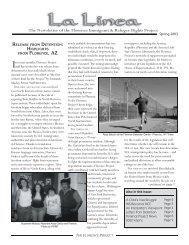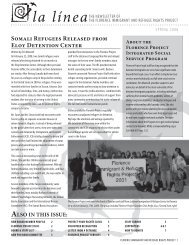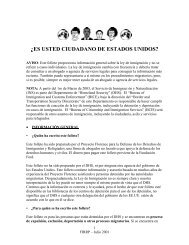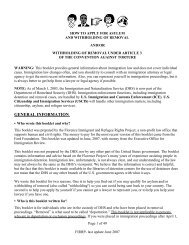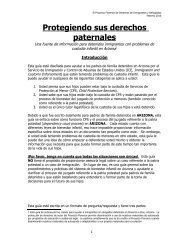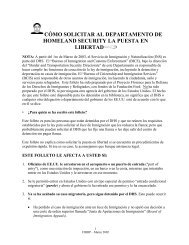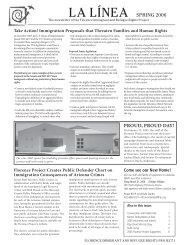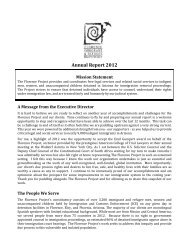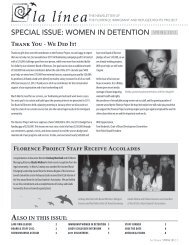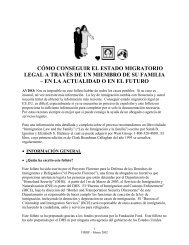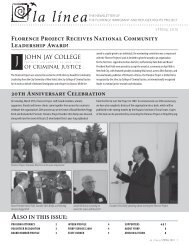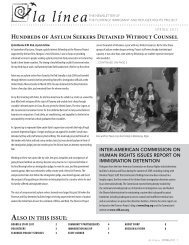quick reference chart and annotations for determining immigration ...
quick reference chart and annotations for determining immigration ...
quick reference chart and annotations for determining immigration ...
Create successful ePaper yourself
Turn your PDF publications into a flip-book with our unique Google optimized e-Paper software.
Immigrant Legal Resource Center, Florence Immigrant <strong>and</strong> Refugee Rights Project,<br />
Maricopa County Public Defender August 2012<br />
2. Distributing an article with the knowledge that the sounds thereon have been so transferred without the<br />
consent of the owner.<br />
3. Distributing or manufacturing an article on which sounds or images have been transferred which does<br />
not bear the true name <strong>and</strong> address of the manufacturer in a prominent place on the outside cover, box,<br />
jacket or label.<br />
4. Distributing or manufacturing the outside packaging intended <strong>for</strong> use with articles which does not bear<br />
the true name <strong>and</strong> address of the manufacturer in a prominent place on the outside cover, box, jacket or<br />
label.<br />
5. Transferring or causing to be transferred to an article any per<strong>for</strong>mance, whether live be<strong>for</strong>e an audience<br />
or transmitted by wire or through the air by radio or television without the consent of the owner <strong>and</strong> with<br />
the intent to obtain commercial advantage or personal financial gain.<br />
6. Distributing an article with knowledge that the per<strong>for</strong>mance on the article, whether live be<strong>for</strong>e an<br />
audience or transmitted by wire or through the air by radio or television, has been transferred without the<br />
consent of the owner.<br />
H. Unlawful copying or sale of sounds or images involving one hundred or more articles containing<br />
sound recordings or one hundred or more articles containing audiovisual recordings is a class 3 felony.<br />
Unlawful copying or sale of sounds or images involving ten or more but less than one hundred articles<br />
containing sound recordings or ten or more but less than one hundred articles containing audiovisual<br />
recordings is a class 6 felony. Unlawful copying or sale of sounds or images involving less than ten<br />
articles containing sound recordings or less than ten articles containing audiovisual recordings is a class 1<br />
misdemeanor.<br />
Summary: This statute is increasingly being used to prosecute illegal downloads <strong>and</strong> the sale of<br />
bootleg music <strong>and</strong> videos. Since there is little case law on point, <strong>immigration</strong> judges may find that it<br />
constitutes a CMT, although counsel may have arguments to the contrary, particularly if the plea is to A1,<br />
A2, or A6. A sentence of 365 days or more may trigger an aggravated felony <strong>for</strong> counterfeiting.<br />
Crime Involving Moral Turpitude (CMT): Probably. The BIA has found that trafficking in<br />
counterfeit goods is a CMT due to the inherently fraudulent nature of the offense <strong>and</strong> the theft of<br />
another’s work. Matter of Kochlani, 24 I&N Dec. 128 (BIA 2007). Immigration counsel can argue that<br />
merely copying music or videos <strong>for</strong> one’s own use is not inherently turpitudinous, but this argument is<br />
undercut by the fact that “distributing” <strong>and</strong> “manufacturing” under the statute are defined to include<br />
commercial advantage or financial gain. There<strong>for</strong>e, since all of the subsections appear to involve a<br />
commercial element, it is likely that the statute will be categorically held a CMT.<br />
Aggravated Felony: An offense relating to counterfeiting in which the sentence imposed is 365<br />
days or more will be an aggravated felony. 8 U.S.C. § 1101(a)(43)(R); Yong Wong Park v. AG of the<br />
United States, 472 F.3d 66 (9th Cir. 2006) (trafficking in counterfeit goods under 18 U.S.C. § 2320 is an<br />
aggravated felony). The Ninth Circuit has defined “counterfeiting” as “knowingly us[ing] or possess[ing]<br />
counterfeit bills with the intent to defraud.” Albillo-Figueroa v. INS, 221 F.3d 1070, 1073 (9th Cir.<br />
2000). Immigration counsel can argue that the statute is categorically not an aggravated felony since it is<br />
missing the element of an intent to defraud, although ICE may argue that fraud is implicit within the<br />
statute. Immigration counsel could also argue that only representations on paper (e.g. securities <strong>and</strong> bills)<br />
fall within the generic definition of counterfeiting. However, the safest route is to secure a sentence of<br />
one year or less; if this is not possible, attempt to plead to A1, A2, or A6, since A3, A4, <strong>and</strong> A5 may be<br />
more likely to resemble an intent to counterfeit. If the loss to the victim is $10,000 or more, ICE may<br />
also charge as an aggravated felony <strong>for</strong> fraud under 8 U.S.C. § 1101(a)(43)(M).<br />
Arizona Criminal Chart with Explanatory Endnote – August 2012<br />
102



